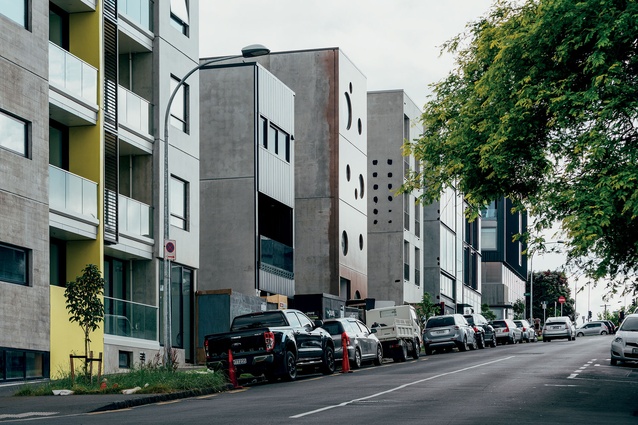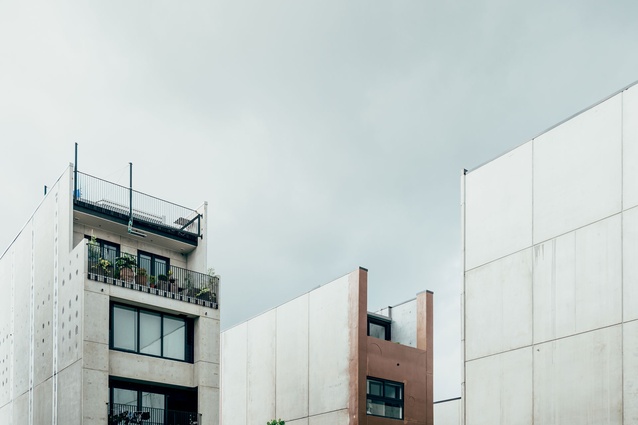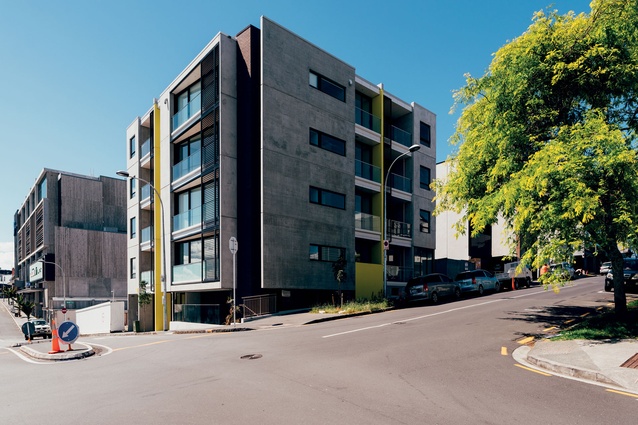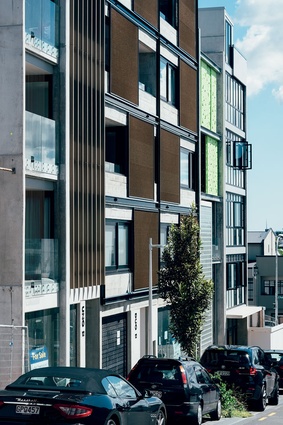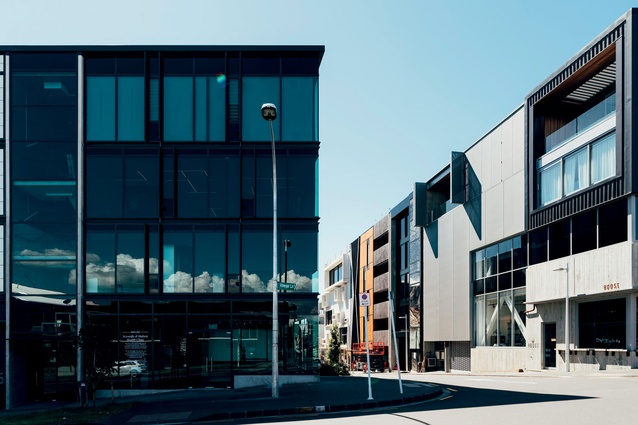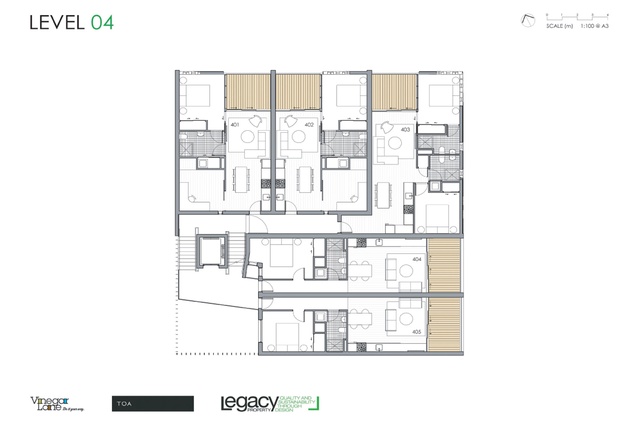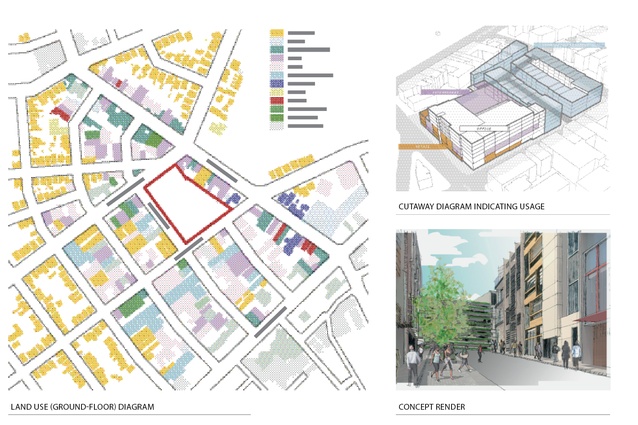Eclectic precinct: Vinegar Lane
In the heart of Ponsonby, an exciting new project offers a unique proposition in terms of mixed-use, medium-density housing. Justine Harvey spoke with the developer, the masterplanners and the architect involved to discover how the scheme came about and whether the concept has a broader future.
The DYC Vinegar company occupied a 1.3ha site between Crummer Road, Williamson Avenue and Pollen Street in Auckland’s Ponsonby for much of the 20th century. The site was then earmarked for a monolithic development, which fell through during the Global Financial Crisis (GFC). In 2011, supermarket operator Progressive Enterprises bought the site and set about planning a unique model for low-rise intensification in Auckland.
The development would include two separate precincts: the Cider Building, which now houses a Countdown supermarket, retail and offices; and Vinegar Lane, which is currently under construction and is essentially a subdivision of freehold individual lots set into tight street networks. Vinegar Lane includes – or will include once fully completed – a selection of townhouses, terraced houses, small apartment buildings, boutique office buildings and hospitality offerings.

Vinegar Lane is designed around a new laneway: a vehicle and pedestrian route that responds to the surrounding street pattern. The overall design reflects the scale and mixed uses of the nearby streets of narrow villas on freehold titles, and it also looks and feels integrated with the existing urban character.
So, how was it possible to create such a unique development in New Zealand and can it be done elsewhere?
The Developer:
Brady Nixon, development manager
What is happening in Auckland at the moment with densification and how does Vinegar Lane fit in?
With apartments in Auckland at the moment, you have to be selling at between $14,000 and $16,000 per square metre to be profitable, which is horrendously expensive. Potential buyers start off with lofty aspirations – they want to live near the city and be near the action. For young families, this becomes even more difficult as they need more space. Pretty quickly, the maths causes people to pull back from those ideas and look at what else they can do with their money.
Auckland is not a huge city. It is still reasonably affordable to live further out.
The apartments built in the city are generally investment stock so we’re not really making huge in-gains. It’s all to do with the sheer cost of building and selling apartments. So, what is the alternative? You look at semi-detached and terraced housing or you consider detached housing, like zero lot detached housing.
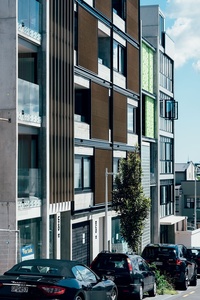
I created a project in Basque Park [in Newton, Auckland] with a site converted into four lots with between one and three dwellings on each. That is a model I fundamentally believe is the most fitting for Auckland as it achieves the best of both worlds; you own the land the house sits on and you end up with different architecture from site to site.
What type of product can you put into the market place that is an easy stepping stone, that is more affordable and that anyone can do, so it appeals to a vastly wider market? Traditionally, you call it subdivision, where you buy a house and carve up the site at the back and you sell it.
But Vinegar Lane is different isn’t it, as you have smaller lots and different architects working on each one?
I had surplus land and two ways to deal with it. One is to sell that land as one parcel but then someone will build a big eyesore of an apartment building and, most likely, it will be a crap offering. You will get a good price though.
But, if you want to maximise the value of the land, then you subdivide. If I subdivide half a hectare of land into 31 sites and then offer those sites as freehold, fee-simple lots – each of which can hold a four-to-five bedroom townhouse on them – into the market for $275,000 plus GST each, in Ponsonby, those are very cheap pieces of land.
Also, I’m going to get a lot more for my money. Rather than sell the land at $1,260 for a square metre, which is what it was worth when we acquired it, we could exit averaging $3,600 so there’s an incentive to do it. The other potential upside is that, if the project comes out well, it would develop kudos in the market in terms of the local catchment and the people who live there. It was really me seizing on an opportunity to develop a concept I had been thinking about for ages.
Did you employ Isthmus from the start?

No. I drew it up myself to start with, in terms of how I wanted the site to be laid out. I employed a surveyor and, from there, took the basic survey plan to David Irwin at Isthmus and said “how are we are going to sell this concept?” We wanted to put together a concept that would, for all intents and purposes, be non-complying. It was going to be a hard ask to get Auckland Council to accept it. When we had the initial chat about it, David Irwin had been thinking along the same lines. This cemented Isthmus in my mind as the people to use for the project.
I dictated the terms and everyone fell in behind. In saying that, when we developed the rules of the project design, it was a collaborative effort but I wanted to retain control of the design: to ban certain materials, to have a height limit and higher stud heights, and for each site to be different.
Pushing for quality is the hardest thing to do. For years, I have said, “don’t put four apartments on top of each other; instead, build one luxury terraced house with four bedrooms.” Will someone buy that? Absolutely! Rundown villas in Ponsonby are selling for one to two million and that’s before doing them up.
Freehold is more attractive to potential buyers too.
Yes, and it’s more attractive to banks as well. If you look at the cost to buy an apartment freehold, the body corporate fees will be half if not the same amount as a mortgage on a house in the suburbs would be; it’s not cheap. I feel apartments are not the way to go for us yet. We don’t have the population and land value and demand to make them sustainable.
Vinegar Lane is an experiment and it would be nice to see someone copy it but they probably won’t. Only someone tenacious like myself with a massive corporate cheque book can make it happen. Council is so notoriously difficult to deal with; people look at that and go: “Nah, I’ll go for something easier”.

What would need to be done to make it easier?
Council would have to make subdivision rules easier but councils want greater levels of control, which makes consenting even harder.
Would you do it again?
If I could, I would. Whether anyone else does, who knows? It’s a quality product and it will look good when finished. At the moment, no one has the money to finish off a few of the sites and the banks are being tight. But, here, no lot is allowed to look the same as the one on either side, creating diversity, and one of the things that turns Kiwis off intensification is that it’s all same-same. They want something more bespoke, that has its own identity and looks interesting – that is the most powerful characteristic of the development. Its going to be a very eclectic precinct of properties.
The Masterplanners:
David Irwin and Ralph Johns from Isthmus.
They build developments like Vinegar Lane in places like Amsterdam, don’t they?
That’s right. This model exists inside Borneo-Sporenburg in Amsterdam, where they ran a design competition. We did it differently – the basic system is a laneway, 14m deep with an open space in the middle for light, but the secret is that you are using mum-and-pop’s finance to develop it.

These buildings are only 6m wide and some are down to 5m wide so they make interesting pieces of architecture in their own right. Some people are using them as their homes, some in work-live scenarios and others have turned them into series of apartments; and there is some commercial and a little bit of retail.
It’s a mixture of building – that fine grain that you see inside Freemans Bay and the back end of Parnell – all those old, cool areas. That is how we built our city: with little bits of money that allow people to play in the development game, or to own a property or part of one that isn’t being controlled by the developer. And the developer doesn’t have to chuck $50 million to build it; they’re using everyone else’s capital.
How did you achieve the density you needed?
The density is way up there but the actual experience of walking around this neighbourhood just feels like Auckland. There is no more than four storeys and it’s fine-grained with heaps of variety – but it is actually really dense. In the context of the Unitary Plan, whereby everyone imagines that density gives you high rise and that it jars with existing neighbourhoods, Vinegar Lane’s design controls ensure that it meshes in with the Ponsonby area. So, while its density is on a par with apartment buildings, the argument is that this fits in better with the scale of the neighbourhood and with our Kiwi psyche.
And not so homogenous, which is one of the problems we have with large housing developments where built landscapes become very generic. Yes, they look the same as everywhere else but this allows people to create their own designs and you can’t have the same architects side by side. We’re calling this Kiwi urbanism. We didn’t take the design from Amsterdam but we took the idea, then looked at and measured the grain of the area to create a way of building in our own way.
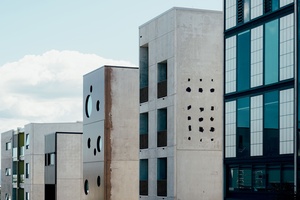
How do you control this thing?
There’s a set of simple rules but there is no aesthetic control; if you want to build round windows and it fits in with what you’re doing conceptually, then you’re allowed to build round windows – and that’s what actually happened.
The idea is that it reflects your own individuality and that is a Kiwi thing. But we struggle as designers, I think, to understand that. Our city is made up of all these little things and together they give off a feeling. So, my argument is the Persian rug analogy – with all this detail woven into it. There are two things: one, if you have a lot going on, it can tell a story and, two, if you spill your red wine on it, it’s not the end of the world.
Whereas, if you have a modernist rug and you spill your red wine on it, it’s stuffed and you have a stain on it. So, the Persian rug is able to absorb irregularity and, of course, in a Persian rug, there are deliberate mistakes built in, so the idea is that you don’t leave it as a perfect offering.
If you go to Japan and study Wabi-sabi (world view), it talks about the acceptance of imperfection as being an aesthetic. If we look around our city, that is actually what we feel comfortable with as a people; we don’t feel comfortable if it all looks the same. But we also want it to be as great a design as possible so it’s no excuse for doing crap. The point is that the collection works as a coherent thing.

The Design Manual that goes with this is about 10 pages long. It says: “you must build 100 per cent site coverage, you can have garaging to the front but you don’t have to have a car park on the site. Everything above the door has to be open and able to be looked into and out of onto the street, so there’s an engagement with the street and with the environment, making the place liveable and feeling like it’s inhabited.”
There are a few minor things about the proportion of the frontage versus the garage door, setbacks, etc., but it’s not long and they’re described in simple words and diagrams. The really important things are controlled but, within that, you can do whatever – letting spontaneity, variety and randomness occur. There are no aesthetic police on this thing! This is about delivering some density in a new form for the city that’s repeatable – you could take it to another site. It’s a way of allowing development to happen in a good inner-city form that’s not an apartment building.
The Architect:
Nick Dalton of TOA Architects
TOA Architects has designed three buildings at Vinegar Lane: Aria Apartments and Lot 4, which are complete, and Rua Tekau (Lot 20), which is awaiting construction.
Can you explain your involvement in Vinegar Lane?
It was a flow-on from Rhubarb Lane, which fell over as a result of the GFC and, also, because it was leasehold. When Vinegar Lane came up, it was a breakthrough because each buyer owns the lot. We were blessed as we ended up designing three projects. We have already built two of them and there is one more to come; the last is our favourite. It’s on a skinny lot in terms of an urban site; it’s 6m wide so it’s tiny. The quality of the materials makes it feel light and airy, despite being small.

What considerations did you make when creating the designs?
There was a design panel and it was fascinating presenting to them but it was also nail-biting. There was David Irwin and architect Pete Bossley, as well as Brady Nixon from Progressive. They would grill you pretty hard. Brady said Aria was the ugliest building he had ever seen and, in the same breath, he said it had the most beautiful entrance he had ever seen. It was relentless in terms of what they would let through. But that rigour is part of what makes the development.
Are there more constraints with this kind of development? And are there commercial issues even on these residential projects?
That’s the challenge! As a New Zealander, if you haven’t travelled, your mind-set of what you feel a house should be is not the world view. To become a proper city, we need to embrace a higher-density model and Vinegar Lane is this nice crossover – it’s not an 80-unit apartment building with monolithic façades.
With Rua Tekau (Lot 20), where the apartments are for sale at the moment, it depends on what happens with that as to when we can start building as there is no appointed contractor yet. That is one of the shortcomings of the development – that there is no clause saying you have to build within a certain time frame. Some people are land-banking sites so it could be a construction site for years. The title took years to come out too.
I’m interested to hear what you think of the financial model. Do you think there is a way this kind of project could be done again in New Zealand?
Absolutely and I think partnering up with a corporate entity means they can take the lion’s share of it. If you look at Kaitaia, they have just boarded up the old premises of Pak’n Save and McDonald’s and built a palm tree paradise on the outskirts, which has basically created a vacuum in the town centre. You look at Detroit and places like that, where it’s happened on a major scale, but now they’re rebuilding in a grassroots way.

The business of New Zealand supermarkets (which includes Countdown and Progressive Enterprises’ franchise businesses) made $6.1 billion [in 2016] so why not take some of that money and reinvest in some of these communities and be a part of repurposing these empty, discarded spaces?
You can also look at the pockets of air above sites. We have a client creating a hotel above a driveway – that land is zero-rated.
With Vinegar Lane, the initial selling cost was reasonable and it was such a different model, which has hopefully broken the mould. But, without the checks and balances in terms of Isthmus’ intervention in the landscaping, the design panel, and the rules about daylight and everything else, it could have been quite grim.
For us to become a real city, we need to embrace apartments and learn how to do them well. And Vinegar Lane is a wonderful opportunity for architects to be involved. If you compare these buildings to the average urban lot, we have 20 small families or professional couples on 320m2, which is the size of one villa. It makes sense.

